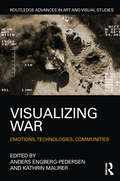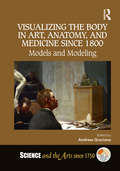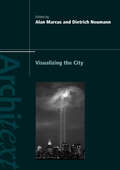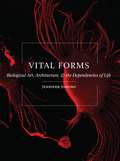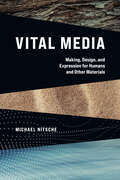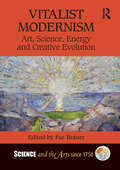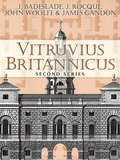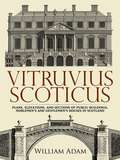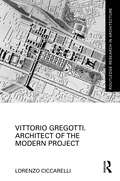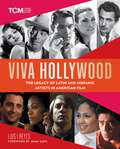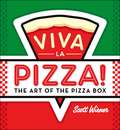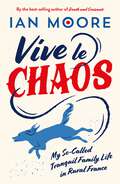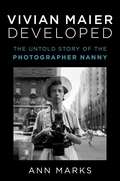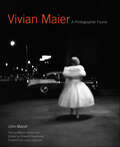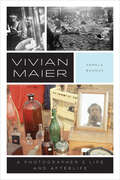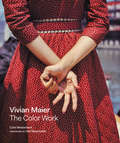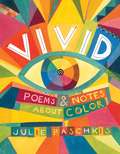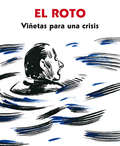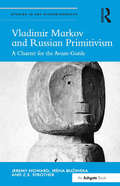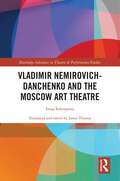- Table View
- List View
Visualizing War: Emotions, Technologies, Communities (Routledge Advances in Art and Visual Studies)
by Anders Engberg-Pedersen Kathrin MaurerWars have always been connected to images. From the representation of war on maps, panoramas, and paintings to the modern visual media of photography, film, and digital screens, images have played a central role in representing combat, military strategy, soldiers, and victims. Such images evoke a whole range of often unexpected emotions from ironic distance to boredom and disappointment. Why is that? This book examines the emotional language of war images, how they entwine with various visual technologies, and how they can build emotional communities. The book engages in a cross-disciplinary dialogue between visual studies, literary studies, and media studies by discussing the links between images, emotions, technology, and community. From these different perspectives, the book provides a comprehensive overview of the nature and workings of war images from 1800 until today, and it offers a frame for thinking about the meaning of the images in contemporary wars.
Visualizing the Afterlife in the Tombs of Graeco-Roman Egypt
by Marjorie Susan VenitLost in Egypt's honeycombed hills, distanced by its western desert, or rendered inaccessible by subsequent urban occupation, the monumental decorated tombs of the Graeco-Roman period have received little scholarly attention. This volume serves to redress this deficiency. It explores the narrative pictorial programs of a group of decorated tombs from Ptolemaic and Roman-period Egypt (ca. 300 BCE 250 CE). Its aim is to recognize the tombs' commonalities and differences across ethnic divides and to determine the rationale that lies behind these connections and dissonances. This book sets the tomb programs within their social, political, and religious context and analyzes the manner in which the multicultural population of Graeco-Roman Egypt chose to negotiate death and the afterlife. "
Visualizing the Body in Art, Anatomy, and Medicine since 1800: Models and Modeling (Science and the Arts since 1750)
by Andrew GracianoThis book expands the art historical perspective on art’s connection to anatomy and medicine, bringing together in one text several case studies from various methodological perspectives. The contributors focus on the common visual and bodily nature of (figural) art, anatomy, and medicine around the central concept of modeling (posing, exemplifying and fabricating). Topics covered include the role of anatomical study in artistic training, the importance of art and visual literacy in anatomical/medical training and in the dissemination (via models) of medical knowledge/information, and artistic representations of the medical body in the contexts of public health and propaganda.
Visualizing the City (Architext)
by Alan Marcus Dietrich NeumannThis anthology presents a range of interdisciplinary explorations into the urban environment, through film, photography, digital imagery, maps and signage. Contributors examine our fascination with the city through the history of art and architecture, urban studies, environmental studies, cultural geography and screen studies.Bringing together a wide spectrum of urban contexts, Visualizing the City’s diverse essays explore visual representations of urbanism and modernity reflected through the prism of global cultures using an engaging variety of methods and texts.
Vital Forms: Biological Art, Architecture, and the Dependencies of Life
by Jennifer JohungShows how the intersection of biotech, art, and architecture are transforming the world we live in As living matter becomes more and more the domain of art and architecture, the life sciences are enabling a major cultural and aesthetic transformation. Vital Forms explores how the intersection of biology, art, and architecture has transformed these disciplines, offering heretofore unimagined possibilities.Using numerous case studies, Jennifer Johung explores how art and architecture are reimagining life on cellular and subcellular levels. In the process, she maps the constantly evolving dependencies that exist between objects, bodies, and environments. From Oron Catts and Ionat Zurr&’s Tissue Culture and Art Project, which developed &“semi-living worry dolls,&” to Patricia Piccinini&’s imagined Still Life with Stem Cells, each chapter pairs a branch of contemporary biological inquiry with the artists who are revolutionizing it.Examining cutting-edge developments in biotechnological research—including tissue-engineering, stem cell science, regenerative medicine, and more—Vital Forms brings biological art and architecture into critical dialogue. Distinguished by its broad range and Johung&’s synthesizing talents, Vital Forms makes powerful observations about how the unfolding dependencies between all kinds of matter are becoming vital to life in our age of biotechnological manipulations.
Vital Media: Making, Design, and Expression for Humans and Other Materials
by Michael NitscheA proposal for a new media design to balance the contributions of humans and materials in the world they share.How can media design support a balance between our needs for self-expression and the material needs of the world we are part of? What criteria define a sustainable media ecology? In Vital Media, Michael Nitsche argues that the current human-centric view is not sustainable and that media are best viewed as dynamic networks where cognitive and noncognitive participants co-create. What we need, according to Nitsche, is a media design that balances the needs of all partners involved: vital media. Tracing this ideal through two domains of expression and making, performance and craft, Nitsche calls on us to embrace material co-existence and to design for self-expression as well as material evolution. We must recognize that the living body and its dependencies on the world around it are at the heart of what media are about. Vital media exist to not only help individuals fulfill their potential through expression but to also realize the agencies of materials in the equally active surrounding world. Throughout the book, Nitsche interweaves theory with close readings of actual artifacts that encompass predigital, nondigital, and hybrid examples. Nitsche&’s approach counters the current tendency to pit the virtual media world against the reality in which we live.
Vitalist Modernism: Art, Science, Energy and Creative Evolution (Science and the Arts since 1750)
by Fae BrauerThis book reveals how, when, where, and why vitalism and its relationship to new scientific theories, philosophies and concepts of energy became seminal from the fin de siècle until the Second World War for such Modernists as Sophie Taeuber-Arp, Hugo Ball, Juliette Bisson, Eva Carrière, Salvador Dalì, Robert Delaunay, Marcel Duchamp, Edvard Munch, Picasso, Yves Tanguy, Gino Severini and John Cage. For them, Vitalism entailed the conception of life as a constant process of metamorphosis impelled by the free flow of energies, imaginings, intuition and memories, unconstrained by mechanistic materialism and chronometric imperatives, to generate what the philosopher Henri Bergson aptly called Creative Evolution. Following the three main dimensions of Vitalist Modernism, the first part of this book reveals how biovitalism at the fin de siècle entailed the pursuit of corporeal regeneration through absorption in raw nature, wholesome environments, aquatic therapies, electromagnetism, heliotherapy, modern sports, particularly rugby, water sports, the Olympic Games and physical culture to energize the human body and vitalize its life force. This is illuminated by artists as geoculturally diverse as Gustave Caillebotte, Thomas Eakins, Munch and Albert Gleizes. The second part illuminates how simultaneously Vitalism became aligned with anthroposophy, esotericism, magnetism, occultism, parapsychology, spiritism, theosophy and what Bergson called "psychic states", alongside such new sciences as electromagnetism, radiology and the Fourth Dimension, as captured by such artists as Juliette Bisson, Giacomo Balla, Albert Besnard, Umberto Boccioni, Eva Carrière, John Gerrard Keulemans, László Moholy-Nagy, James Tissot, Albert von Schrenck Notzing and Picasso. During and after the devastation of the First World War, the third part explores how Vitalism, particularly Bergson’s theory of becoming, became associated with Dadaist, Neo-Dadaist and Surrealist notions of amorality, atemporality, dysfunctionality, entropy, irrationality, inversion, negation and the nonsensical captured by Hans Arp, Charlie Chaplin, Theo Van Doesburg, Kazimir Malevich, Kurt Schwitters and Vladimir Tatlin alongside Cage’s concept of Nothing. After investigating the widespread engagement with Bergson’s philosophies and Vitalism and art by Anarchists, Marxists and Communists during and after the First World War, it concludes with the official rejection of Bergson and any form of Vitalism in the Soviet Union under Stalin. This book will be of vital interest to gallery, exhibition and museum curators and visitors, plus readers and scholars working in art history, art theory, cultural studies, modernist studies, occult studies, European art and literature, health, histories of science, philosophy, psychology, sociology, sport studies, heritage studies, museum studies and curatorship.
Vitruvius Britannicus: Second Series
by John Woolfe J. Rocque J. Badeslade James GandonThe Baroque excesses of the early eighteenth century inspired a rebellion among a consortium of British architects and their patrons. Taking their cue from the Renaissance works of Andrea Palladio, these Neo-Palladians returned the direction of British architecture toward classical principles. The Vitruvius Britannicus (British Vitruvius) reflects their vision, offering magnificent copperplate engravings of great English country houses and public buildings. The sequel to Dover’s first edition of Vitruvius Britannicus, this volume comprises three folios, originally published between 1739 and 1771. More than one hundred plates depict facades, ground plans, exterior elevations, and perspective views of grand buildings, including royal palaces at Richmond, Kensington, and Hampton Court as well as country homes and gardens throughout England and Scotland. The Neo-Palladian works featured in this volume and its predecessor continue to influence architects and designers. Handsome and modestly priced, this new edition of an architectural classic is an essential complement to any design library.
Vitruvius Scoticus: Plans, Elevations, and Sections of Public Buildings, Noblemen's and Gentlemen's Houses in Scotland (Dover Architecture)
by James Simpson William AdamThis classic portfolio uses elevations, floor plans, and other line drawings by Scotland's first great classical architect to document the high Scottish style of the eighteenth century. It was assembled by William Adam (1689-1748), whose sons were the developers of the "Adam style," and published posthumously in 1812. The elder Adam designed, extended, and remodeled numerous country homes and undertook many public contracts. Vitruvius Scoticus's 160 plates include 100 of his own designs.Unlike the Vitruvius Britannicus books, this volume features plans for many smaller buildings that served as models for American builders and architects of the nineteenth century. Its engravings include images of such stately homes as Mavisbank House, Haddo House, and Fasque House; Hamilton Palace, one of the nation's grandest homes, and Holyrood Palace, the official residence of the monarch in Scotland; and a series of bridges at Inveraray in the county of Argyll. Never before available in an affordable edition, this volume is an essential reference for architectural historians and students. It includes an Introduction and Notes to the Plates by James Simpson.
Vitruvius: Ten Books on Architecture
by Ingrid D. Rowland Thomas Noble HoweFor the first time in more than half a century, Vitruvius' Ten Books on Architecture is being published in English. The only full treatise on architecture and its related arts to survive from classical antiquity, the Architecture libri decem (Ten Books on Architecture) is the single most important work of architectural history in the Western world, having shaped architecture and the image of the architect from the Renaissance to the present. Demonstrating the range of Vitruvius' style, this new edition includes examples from archaeological sites discovered since World War II and not previously published in English language translations. Rowland's new translation and Howe's critical commentary and illustrations provide a new image of Vitruvius, who emerges as an inventive and creative thinker, rather than the normative summarizer, as he was characterized in the Middle Ages and Renaissance. Ingrid D. Rowland is an associate professor of Art History at the University of Chicago. Thomas Noble Howe is a professor in the Department of Art at Southwestern University in Georgetown, Texas.
Vitruvius: The Ten Books on Architecture
by Morris Hicky MorganFor the first time in more than half a century, Vitruvius' Ten Books on Architecture is being published in English. The only full treatise on architecture and its related arts to survive from classical antiquity, the Architecture libri decem (Ten Books on Architecture) is the single most important work of architectural history in the Western world, having shaped architecture and the image of the architect from the Renaissance to the present. Demonstrating the range of Vitruvius' style, this new edition includes examples from archaeological sites discovered since World War II and not previously published in English language translations. Rowland's new translation and Howe's critical commentary and illustrations provide a new image of Vitruvius, who emerges as an inventive and creative thinker, rather than the normative summarizer, as he was characterized in the Middle Ages and Renaissance.
Vittorio Gregotti. Architect of the Modern Project (Routledge Research in Architecture)
by Lorenzo CiccarelliThis is not only a book about Vittorio Gregotti’s projects and works, but rather a historical‑critical analysis of his peculiar figure. Like a few others, Gregotti embodied the model of the architect‑intellectual that characterised post‑war Italian design culture. Editor of leading magazines, author of influential books and essays, professor at prestigious universities, curator of memorable exhibitions and events such as the 1976 Venice Biennale and founder of a firm that developed a wide range of projects for over 40 years, Gregotti tenaciously occupied all the territories available to the architectural profession, promoting cultural and design trends and triggering long‑lasting controversies.This book examines the formation of Gregotti’s theoretical positions around the notions of territory and modification, the connection with the profession, the relationship with history and the tradition of modern architecture, the notion of critical internationalism and the idea of the city and urban design in an era of increasing disurbanism. All aspects of a cultural project aimed at shaping and elaborating a certain tradition of modern architecture in the different social and economic conditions of his time, namely the emerging society of entertainment and consumption, and then of information technologies and global financial markets.This work will be of interest to postgraduate researchers and academics in architectural theory and history, as well as urban design and planning theory and history.
Viva Hollywood: The Legacy of Latin and Hispanic Artists in American Film (Turner Classic Movies)
by Luis I. ReyesThrough an authoritative narrative and lavish photography, this is an in-depth history of the stars, films, achievements, and influence of the Hispanic and Latino community in Hollywood history from the silent era to the present day.Overcoming obstacles of prejudice, ignorance, and stereotyping, this group has given the world some of its most beloved stars and told some of its most indelible stories. Viva Hollywood examines the stars in front of the screen as well as the people behind-the-scenes who have created a rich legacy across more than 100 years.The role of Latin women on screen is explored through the professional lives of Dolores Del Rio, Rita Hayworth, Raquel Welch, Salma Hayek, Penélope Cruz, and many more. The book covers the films and careers of actors ranging from silent screen idol Antonio Moreno, to international Oscar-winning star Anthony Quinn, to Andy Garcia and Antonio Banderas. A spotlight is also given to craftspeople who elevated the medium with their artistry—visionaries like cinematographer John Alonzo, Citizen Kane scenic artist Mario Larrinaga, and Oscar-winning makeup artist Beatrice de Alba.The stories of these and many others begins through a lens of stereotyped on-screen personas of Latin Lovers, sexy spitfires, banditos, and gangsters. World War II saw an embrace of Latin culture as the &“Good Neighbor Policy&” made it both fashionable and patriotic to feature stories set south of the border. Social problem films of the 1950s and '60s brought fresh looks at the community, with performances like Katy Jurado in High Noon, the cast of West Side Story, and racial inequality depicted in George Stevens's Giant. Civil Rights, the Chicano Movement, and the work of activist actors such as Ricardo Montalban and Edward James Olmos influenced further change in Hollywood in subsequent decades and paved the way for modern times and stars the likes of Jennifer Lopez and Lin-Manuel Miranda.Illustrated by more than 200 full-color and black-and-white images, Viva Hollywood is both a sweeping history and a celebration of the legacy of some of the greatest art and artists ever captured on screen.
Viva Poncho
by David Verba Leslie Barbazette Christina StorkWhether worn as a beach cover-up or donned as an elegant evening wrap, ponchos are everywhere. Now, with Viva Poncho, knitters can make the newest sartorial sensation their own. This fun, fresh book offers 20 poncho designs for every season and in every style--serapes, raglans, wraparounds, semicircles, rectangles, pullovers, capelets, and even a dog poncho. Patterns suitable for both beginners and experienced knitters are included, all accompanied by clear, easy-to-follow explanations. Simple to make and give as gifts (since sizing is easy), practical and stylish to wear, and suitable for all sorts of creative adaptations, ponchos are an ideal project for every knitter. In fact, the authors encourage customization, showing how to add a hood or a collar, or devise personalized color schemes. Like the fashionable garments themselves, Viva Poncho will be the perfect impulse buy.
Viva Poncho: Twenty Ponchos and Capelets to Knit
by Leslie Barbazette Christina StorkTwenty knit poncho designs that &“could fit right into the pages of Vogue, Nylon and Lucky,&” complete with &“fashionista photos&” and &“clear instructions&” (Publishers Weekly). Whether worn as a beach cover-up or donned as an elegant evening wrap, ponchos are everywhere. Now, with Viva Poncho, knitters can make the newest sartorial sensation their own. This fun, fresh book offers 20 poncho designs for every season and in every style--serapes, raglans, wraparounds, semicircles, rectangles, pullovers, capelets, and even a dog poncho. Patterns suitable for both beginners and experienced knitters are included, all accompanied by clear, easy-to-follow explanations. Simple to make and give as gifts (since sizing is easy), practical and stylish to wear, and suitable for all sorts of creative adaptations, ponchos are an ideal project for every knitter. In fact, the authors encourage customization, showing how to add a hood or a collar, or devise personalized color schemes. Like the fashionable garments themselves, Viva Poncho will be the perfect impulse buy.
Viva la Pizza!: The Art of the Pizza Box
by Scott Wiener"New Yorkers are particular about pizza, and no one has a more well-formed opinion than Scott Wiener." --NewsdayOne of the world's foremost pizza experts presents more than 100 weird and wild pizza box designs Since the origins of to-go pizza, pizzerias and pizza chains have taken great pride in covering take-out boxes with captivating designs. They've also wrestled with the best way to manufacture a box that can keep a pizza looking and tasting great. Here, the world's expert on pizza boxes presents more than one hundred weird and wild box designs and explores the curious history of the pizza box. Included are international designs, corporate designs, and dozens of quirky images from mom-and-pop pizzerias. Where does all this art come from? Scott Wiener has been collecting and cataloging pizza boxes for more than five years. In Viva la Pizza!, Wiener traces design trends over the past four decades and profiles some of the world's most prolific box designers and manufacturers. The result is a captivating overview of pizza culture and a new way to look at one of the world's favorite foods.From the Hardcover edition.
Vive le Chaos: My So-Called Tranquil Family Life in Rural France
by Ian MooreFollow the hilarious misadventures of Ian Moore and his family as their search for serenity in rural France leads them on a journey of chaos, commotion and comedy. But despite the ups and downs, the Moore family persevere in true Brit style to create a unique, colourful and ultimately rewarding life in their new home - à la campagne!
Vivian Maier Developed: The Untold Story of the Photographer Nanny
by Ann MarksThe definitive biography that unlocks the remarkable story of Vivian Maier, the nanny who lived secretly as a world-class photographer, featuring nearly 400 of her images, many never seen before, placed for the first time in the context of her life.Vivian Maier, the photographer nanny whose work was famously discovered in a Chicago storage locker, captured the imagination of the world with her masterful images and mysterious life. Before posthumously skyrocketing to global fame, she had so deeply buried her past that even the families she lived with knew little about her. No one could relay where she was born or raised, if she had parents or siblings, if she enjoyed personal relationships, why she took photographs and why she didn&’t share them with others. Now, in this definitive biography, Ann Marks uses her complete access to Vivian&’s personal records and archive of 140,000 photographs to reveal the full story of her extraordinary life. Based on meticulous investigative research, Vivian Maier Developed reveals the story of a woman who fled from a family with a hidden history of illegitimacy, bigamy, parental rejection, substance abuse, violence, and mental illness to live life on her own terms. Left with a limited ability to disclose feelings and form relationships, she expressed herself through photography, creating a secret portfolio of pictures teeming with emotion, authenticity, and humanity. With limitless resilience she knocked down every obstacle in her way, determined to improve her lot in life and that of others by tirelessly advocating for the rights of workers, women, African Americans, and Native Americans. No one knew that behind the detached veneer was a profoundly intelligent, empathetic, and inspired woman—a woman so creatively gifted that her body of work would become one of the greatest photographic discoveries of the century.
Vivian Maier: A Photographer Found
by John MaloofThe definitive monograph of American photographer Vivian Maier, exploring the full range and brilliance of her work and the mystery of her life, written and edited by noted photography curator and writer Marvin Heiferman; featuring 250 black-and-white images, color work, and other materials never seen before; and a foreword by New York Times bestselling author Laura Lippman.Vivian Maier’s story—the secretive nanny-photographer during her life who becomes a popular sensation shortly after her death—has, to date, been pieced together only from previously seen or known images she made and the handful of facts that have surfaced about her life. During her lifetime she shot more than 100,000 images, which she kept hidden from the world. In 2007, two years before her death, Chicago historic preservationist John Maloof discovered a trove of negatives, and roll upon roll of undeveloped film in a storage locker he bought at auction. They revealed a surprising and accomplished artist and a stunning body of work, which Maloof championed and brought to worldwide acclaim. Vivian Maier presents the most comprehensive collection and largest selection of the photographer’s work—created during the 1950s through the 1970s in New York, Chicago, and on her travels around the country—almost exclusively unpublished and including her previously unknown color work. It features images of and excerpts from Maier’s personal artifacts, memorabilia, and audiotapes, made available for the first time. This remarkable volume draws upon recently conducted interviews with people who knew Maier, which shed new light on Maier’s photographic skill and her life.
Vivian Maier: A Photographer's Life and Afterlife
by Pamela Bannos“Look[s] past the mystique of the ‘eccentric nanny with a camera’ to tell the true Maier story . . . [An] extraordinary work.” —Library JournalWho was Vivian Maier? Many know her as the reclusive Chicago nanny who wandered the city for decades, constantly snapping photographs, which were unseen until they were discovered in a seemingly abandoned storage locker. They revealed her to be an inadvertent master of twentieth-century American street photography. Not long after, the news broke that Maier had recently died and had no surviving relatives. Soon the whole world knew about her preternatural work, shooting her to stardom almost overnight.But as Pamela Bannos reveals in this meticulous biography, this story of the nanny savant has blinded us to Maier’s true achievements, as well as her intentions. Most important, Bannos argues, Maier was not a nanny who moonlighted as a photographer; she was a photographer who supported herself as a nanny. In Vivian Maier: A Photographer’s Life and Afterlife, Bannos contrasts Maier’s life with the mythology that strangers—mostly the men who’ve profited from her work—have created around her absence. She shows that Maier was extremely conscientious about how her work was developed, printed, and cropped, even though she also made a clear choice never to display it. She places Maier’s fierce passion for privacy alongside the recent spread of her work around the world, and explains Maier’s careful adjustments of photographic technique, while explaining how the photographs have been misconstrued or misidentified. Bannos also uncovers new information about Maier’s immediate family, including her difficult brother, Karl—relatives once thought not to exist. This authoritative biography shows that the real story of Vivian Maier, a true visionary artist, is even more compelling than the myth.“An excellent book that reads like a mystery novel . . . Wonderful and engrossing.” —Elizabeth Currid-Halkett, author of Starstruck: The Business of Celebrity“It’s a portrait as direct as any of Maier’s, and what a distinct pleasure it is to meet her gaze again.” —The New York Times“This book is by far the finest yet published on the artist. I believe it will become a classic in the field.” —Art in America
Vivian Maier: The Color Work
by Colin WesterbeckThe first definitive monograph of color photographs by American street photographer Vivian Maier.Photographer Vivian Maier’s allure endures even though many details of her life continue to remain a mystery. Her story—the secretive nanny-photographer who became a pioneer photographer—has only been pieced together from the thousands of images she made and the handful of facts that have surfaced about her life. Vivian Maier: The Color Work is the largest and most highly curated published collection of Maier’s full-color photographs to date. With a foreword by world-renowned photographer Joel Meyerowitz and text by curator Colin Westerbeck, this definitive volume sheds light on the nature of Maier’s color images, examining them within the context of her black-and-white work as well as the images of street photographers with whom she clearly had kinship, like Eugene Atget and Lee Friedlander. With more than 150 color photographs, most of which have never been published in book form, this collection of images deepens our understanding of Maier, as its immediacy demonstrates how keen she was to record and present her interpretation of the world around her.
Vivid: Poems & Notes About Color
by Julie PaschkisPlayful poems and facts celebrate the colors of the rainbow in this beautiful nonfiction picture book. Orange you sweet? Orange you plump and juicy? Orange you my favorite fruit?Hey - you’re a tangerine!B-lime-y.With information about the science of sight and perception, pigment origins in art and textiles, colloquial expressions and word associations, there's so much to see in each vivid spread—a wonderfully sensory read.- GODWIN BOOKS -
Viñetas para una crisis
by El RotoPrimera antología de las viñetas de El Roto que muestran su lúcida y lacónica visión sobre la crisis. Andrés Rábago («El Roto») es Premio Leyenda 2015, un galardón concedido por el Gremio de Libreros de Madrid. «Con papel, tinta negra y algo de lucidez es posible fabricar un revelador universal que nos permita fijar la imagen de todo aquello que no deja de molestarnos y hacer más difíciles nuestras vidas, y así, una vez revelado, poder verlo en cualquier lugar y bajo cualquier disfraz con el que se nos presente. El instrumento de la sátira nos dota de esos rayos X con los que, literalmente, podemos verle los huesos al sistema.»El Roto
Vladimir Markov and Russian Primitivism: A Charter for the Avant-Garde (Studies in Art Historiography)
by Jeremy Howard Irena Bužinska Z.S. StrotherHailed as a brilliant theoretician, Voldemārs Matvejs (best known by his pen name Vladimir Markov) was a Latvian artist who spearheaded the Union of Youth, a dynamic group championing artistic change in Russia, 1910-14. His work had a formative impact on Malevich, Tatlin, and the Constructivists before it was censored during the era of Soviet realism. This volume introduces Markov as an innovative and pioneering art photographer and assembles, for the first time, five of his most important essays. The translations of these hard-to-find texts are fresh, unabridged, and authentically poetic. Critical essays by Jeremy Howard and Irena Buzinska situate his work in the larger phenomenon of Russian ’primitivism’, i.e. the search for the primal. This book challenges hardening narratives of primitivism by reexamining the enthusiasm for world art in the early modern period from the perspective of Russia rather than Western Europe. Markov composed what may be the first book on African art and Z.S. Strother analyzes both the text and its photographs for their unique interpretation of West African sculpture as a Kantian ’play of masses and weights’. The book will appeal to students of modernism, orientalism, ’primitivism’, historiography, African art, and the history of the photography of sculpture.
Vladimir Nemirovich-Danchenko and the Moscow Art Theatre (Routledge Advances in Theatre & Performance Studies)
by Inna SolovyovaThis is an authorized translation of Nemirovich-Danchenko (Moscow, 1979) by Inna Solovyova, historian, author, and senior researcher of the Moscow Art Theatre Archives.Untranslated before now, it is the only comprehensive account of the life and work of Vladimir Nemirovich-Danchenko (1858–1943), co-founder with Konstantin Stanislavsky of the Moscow Art Theatre and one of the pioneers of the art of directing. Nemirovich-Danchenko was one of the few prominent theatre practitioners who lived and worked from Russia’s Tsarist period through the inception and consolidation of its Soviet period. Thus, it is also a story about the development of Russian society and culture during the last half of the nineteenth century and the Soviet half of the twentieth century. Additionally, it explores the Moscow Art Theatre’s interpretive and production work on the plays of Chekhov, Shakespeare, Ibsen, Dostoevsky, Leo Tolstoy, Maxim Gorky, and many others. The central theme of the book focuses on the contingent dialectical relationship between artists and their changing socio-political realities.The author’s narrative is stylistically informal and based on archival documents, most of which are referenced here for the first time in English and will be of great interest to students and scholars in theatre and performance studies.
